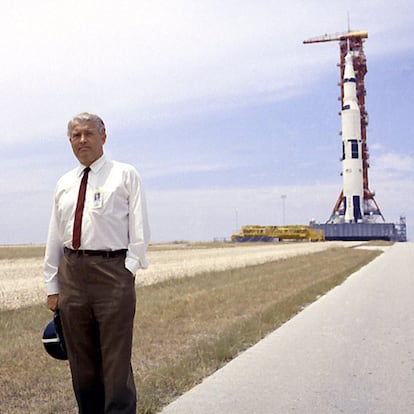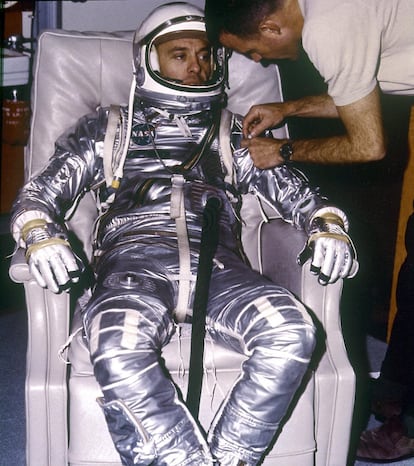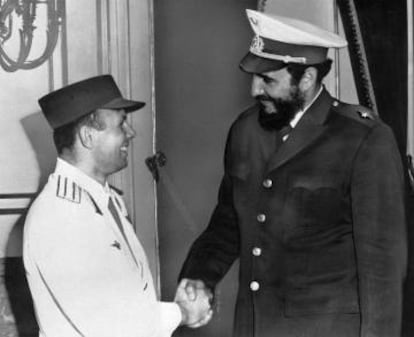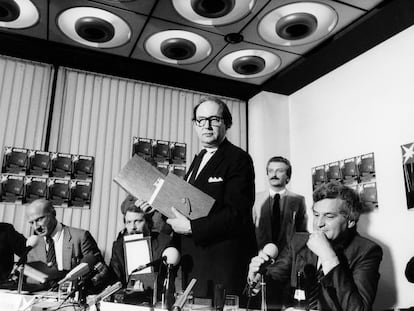British filmmaker and author Stephen Walker: ‘If Hitler had won the war, Von Braun would have taken the Nazis to the moon’
In ‘Beyond,’ Walker chronicles the space race between the Soviet Union and the U.S. He masterfully reconstructs the epic flight of Yuri Gagarin, the first human to leave the Earth and point the way to the stars


The shocking images of Nazis on the Moon — as seen in the outrageous film Iron Sky (2012) — could have been real if the Third Reich had won World War II. British filmmaker and author Stephen Walker agrees with this. In his book on the space race — Beyond: The Astonishing Story of the First Human to Leave Our Planet and Journey into Space (2021) — he’s very clear that there would have indeed been a National Socialist space program had the war gone in a different direction. He writes that the Nazis had rockets, such as the famous V-2s, and a genius who could have developed them further, Wernher von Braun (who would go on to craft designs for the United States).
“Von Braun dedicated himself to making weapons. [This was] miraculous for Hitler… but his dream and his priority objective was the conquest of space. He was very persuasive,” explains Walker, 61, from his home in London. “He would have put the swastika on the moon, certainly.”
This would, of course, have required the Germans to win. During World War II, the last thing that Hitler and the German economy were thinking about was the Moon. However, a hypothetical Nazi space program would have been different from the ones put together by the United States and the USSR (although somewhat more similar to the latter, as it was also a dictatorship), since the basic element that unleashed the space race between the two powers would have been missing: the rivalry that gave rise to to the Cold War.
Finally, upon the Nazi defeat in 1945, the Americans caught Von Braun and took advantage of his knowledge of rocketry. The Soviets, meanwhile, caught other German scientists. This meant that both space programs were started with resources and people who were captured from Hitler.
And what of the United Kingdom? Didn’t the British want to enter the space race? “There was some ambition, but the other two Allies kept the Nazi technicians and their plans. In any case, Britain was bankrupt [after the war]… it was unthinkable that a space program would emerge. And Churchill [and Attlee] didn’t give it much importance,” Walker notes.
Walker emphasizes that Von Braun — despite the fact that the U.S. government cleansed his record, or that he appeared on Walt Disney’s television programs to smilingly talk about space — was “an amoral criminal, an unscrupulous guy, who was a member of the SS with the rank of Sturmbannführer. [As a Nazi commander], he used slave labor to build the V-2s.” Walker’s scathing profile of Von Braun is deeply personal: “My mother was almost killed by a V-2.” Von Braun — the man who filled London with craters caused by his rockets — “ironically has one on the moon named after him,” the author laments.

In principle, the rockets inherited by the Americans and Soviets weren’t going to be used for the conquest of space, but rather to continue their mission of extermination, by carrying nuclear warheads. But the two powers quickly realized the strategic and propaganda value of going into space (“Control of outer space entails control of the world,” then-Senator Lyndon B. Johnson warned, in 1958). This rivalry would lead humanity to cross its own borders.
Yuri Gagarin — the first man in space, measuring a svelte 5 ft 4 inches (he had to fit in the capsule) — takes up many pages of Walker’s masterfully-written book, including some of the most brilliant descriptions. “I never thought of the book as a biography of Gagarin, but as a portrait of a moment in time.” His, he says, “isn’t only the story of an intrepid man who went to space and paved our way to the stars while facing terrible uncertainties… [it’s the story] of the extraordinary people who surrounded him — among them most especially Chief Sergei Korolev, the secret Soviet genius father of the USSR program — and [an entire generation] which saw the space adventure as a true battlefield.”
Walker — who has visited the original launch sites and has observed contemporary takeoffs — enriches his story with extraordinary literary breadth and numerous interviews with survivors of the space race and their families. A large part of the book focuses on the six months that culminated with Gagarin’s launch from Vostok Station in Antarctica, on April 12, 1961. Around this storyline, the entire phenomenon of the space race is neatly condensed. Several years are covered, from the overwhelming Soviet success that was the 1957 launch of Sputnik into orbit (which caused a wave of panic in the United States), to the moon landing of Apollo 11 in 1969.
The writer discovers a paradox in this story. Despite having worse technology, the USSR achieved all the first great successes in the space race. But, Walker notes, all of this was achieved precisely because the USSR’s technology was so inferior. Soviet atomic bombs were more primitive and weighed a lot, so the scientists were forced to develop enormous and very powerful rockets to carry them, such as the R-7. “They were behind, and that’s why they overtook the Americans,” Walker explains. These large rockets — which were basically missiles — made it possible (by adapting them and changing the thermonuclear warheads at the tip for capsules) to conquer space.
Furthermore, the communist dictatorship didn’t have to account for its errors or exercise transparency—– factors not available to American democracy. Those responsible for the U.S. space program had to be more cautious when sending someone up into space: they couldn’t allow an astronaut from their country to turn into ashes when a rocket exploded before the television cameras and millions of viewers. Soviet secrecy, on the other hand, allowed failures to go unnoticed — only triumphs became public knowledge. “The risks that the Soviets took were incredible, all with a technology that surprises us today, [considering] how precarious it was.”

Another paradox that Walker highlights is that, if the Americans had been ahead in the space race, the Moon probably wouldn’t have been reached in 1969. It was President Kennedy’s will in the face of Soviet successes that pushed him and the United States to conspire to do something enormous (and very expensive) before their opponents could.
The writer points out how incredible the achievements of the space race were. It had only been 60 years since the Wright brothers had taken flight and humanity was already leaving the Earth. “I saw the Moon landing with my grandfather, who had been a pilot in World War I… that’s how quickly we went to space,” Walker notes. There was, however, a bit of a slowdown afterwards. “As a child, I was sure I would take my children on vacation to the Moon. That hasn’t happened,” he jokes. One reason is that the push motivated by the rivalry between the two superpowers was eventually lost by the late-1980s, when the Cold War ended.
Walker is fascinated by the mystique of the Soviet cosmonauts. His book focuses on those recruited for the first flight — the so-called “Vanguard Six” — rather than on the American “Mercury Seven” (Glenn, Grissom, Schirre, Shepard, etc.), who were all military test pilots.
The Soviets, he notes, were (and are, as he has interviewed many) more poetic and philosophical when talking about space and the beauty of their observations up there than the Americans, who, in his opinion, were “more technocratic and boring.” The differences, he believes, show the depth of the cultural schism between the two countries. Although, of course, there were some similarities, such as the fact that there were no women in either program during the initial years of the space race. We had to wait until 1963, when Valentina Tereshkova participated in the USSR’s Vostok 6 spaceflight. Meanwhile, the first American astronaut, Sally Ride, made it to space 20 years later, in 1983.

The writer gets emotional when talking about Gagarin. “His is the story of a man doing the incredible, taking the first step into the cosmos. When you enter orbit and look out the window of the small sphere that you’re travelling in and see something that no one has ever seen before — the Earth in all its beauty, the stars like otherworldly lights — all of that is magical. I’ve tried to take the reader there.”
Still, Walker considers Gagarin to be less interesting than Gherman Titov, the backup cosmonaut, “the Soviet Buzz Aldrin.” Vital and rebellious, Titov loved Pushkin and could recite entire passages by heart. Gagarin, meanwhile, “was like a sphinx. He had a smile that captivated everyone, but he could be whoever you wanted him to be. And that — without forgetting his incredible courage and endurance — [made him key] for the Soviet authorities, who wanted someone who was moldable. He was a chameleon, very difficult to define.”
In Beyond, Walker writes about the trauma behind Gagarin: he lived through the Nazi invasion and, at the age of seven, he saw how a soldier hung his brother from a tree. He ended up saving him with the help of his mother, but there were lifelong consequences (his brother ended up committing suicide by hanging). Walker also points out that the first communist to ascend to the heavens was the son of a humble carpenter…
The writer tries to describe what it was like to be a cosmonaut at the time. Gagarin — who came from the world of combat aviation — suddenly found himself on a rocket that had been designed to carry nuclear weapons, with “a 50% chance that everything would explode. It took a lot of courage.” He highlights the “tremendous risks that were taken, which the Soviets lied about for decades.”

After Garagin’s extraordinary flight — in which he almost died (the Vostok began to spin out of control) — “the man of destiny” didn’t return to Earth in his ship. Rather, he was ejected and arrived by parachute, carrying a revolver and a hunting knife. If he ended up in enemy territory and was captured, he only had to say: “Moscow, Cosmos.” There were no crowds waiting for him in the farm field where he fell. Instead, he found two frightened peasant women and a cow. “I come from heaven,” he told them. “Is there a telephone?” Fortunately, the letters CCCP (USSR) had been painted on his spacesuit at the last minute.
Walker points out that Gagarin — who left the Earth shouting “Poyekhali!” (“Here we come!”) — was perfect to be the first man in space. However, this experience would cost him dearly. “And that’s the paradox of Gagarin: being the most famous man in the world destroyed him.” Upon his return — after the celebrations and tributes — many things began to go wrong in his life. “He began to drink a lot. There was one incident where he jumped from a terrace trying not to be discovered with a lover… he was left with a permanent scar as testimony of his infidelity.”
Derailed, he wanted to go back to space. But in his place, the Soviet authorities sent Vladimir Komarov, who was burned to death. After this, Gagarin revolted furiously against the authorities: “We’re going too fast, we have to stop,” he implored. The fall of Premier Khrushchev — who supported and esteemed him greatly — was another misfortune for the cosmonaut. And then came the plane accident involving a Mig-15, which killed him in 1968. He was only 34-years-old. “No one knows for sure what happened. As in the cases of Lady Di or Kennedy, it’s easy to create conspiracy theories. His father was convinced that [the state] had killed him. It’s a controversial subject.”

The Gagarin myth — although it lost ground in the rest of the world as Neil Armstrong became a phenomenon — hasn’t stopped growing in Russia, where he is venerated almost like a saint. Even Putin, Walker points out, has appropriated him. In fact, there are many similarities between today’s Russian nationalism (which supports the invasion of Ukraine) and the sentiments sparked by Gagarin’s feat. Back then, Russians said to themselves: “At the end of World War II our country was devastated, with millions of deaths, and just 16 years later, we managed to be the first in space, ahead of the United States.”
Walker closes his book with a few words about Gagarin, summarizing all the grandeur and beauty of his presence in space. They continue to resonate in your head when you look up at the sky: “He had encircled the earth and he had seen the stars. He had seen the night and then the new day racing towards his little ship. He had seen the impossible beauty of the atmosphere that enables life to exist; and he had seen its impossible thinness, too. He had seen it all. And he had come back.”
The terrible story of animals in space
Beyond also offers — in horrifying detail and with great sensitivity — the atrocities that were committed (on both sides) against animals during the space race. The USSR sent up 41 dogs, including Laika — the first dog to go to space, who died there — on flights in which there was no possibility of rescue. The animals suffered unspeakable pain. A little dog managed to escape when they were taking her to their rocket — the Soviets replaced her with the first dog they found on the street, an unfortunate puppy. And, on the American side, there’s the terrible story of a chimpanzee named Ham.

“These animals — especially dogs from the USSR and apes from the U.S. — were actually the first beings on Earth to go into space,” Walker emphasizes. “Their stories are fascinating, but terrifying. I met and interviewed Adilya Kotovskaya — the top Soviet person in charge of the dog program (who also tested Gagarin) — and a new world opened up to me. Those creatures were the silenced heroes of the space race. Of course, they weren’t volunteers. Their inability to understand what was happening to them — and the lack of mercy, cruelty and harshness with which they were treated — is one of the saddest and most regrettable chapters in the conquest of space.”
“[Think of] the chimponaut, Ham, who was kidnapped in the Cameroonian jungle. This is an especially important story because of the hardships he suffered — including electric shocks — [and because the tests they did on him] caused changes in the U.S. space project that even affected the Apollo program. When looking at the photos of Ham tied up in his capsule, Jane Goodall said she had never seen more extreme terror reflected on the face of a chimpanzee.”
Well, at least cats weren’t sent into space. “I’m afraid so, sorry,” Walker corrects this interviewer sadly. “The French used them. They sent several [into space] and then sacrificed the ones who survived [for the autopsies].”
Sign up for our weekly newsletter to get more English-language news coverage from EL PAÍS USA Edition
Tu suscripción se está usando en otro dispositivo
¿Quieres añadir otro usuario a tu suscripción?
Si continúas leyendo en este dispositivo, no se podrá leer en el otro.
FlechaTu suscripción se está usando en otro dispositivo y solo puedes acceder a EL PAÍS desde un dispositivo a la vez.
Si quieres compartir tu cuenta, cambia tu suscripción a la modalidad Premium, así podrás añadir otro usuario. Cada uno accederá con su propia cuenta de email, lo que os permitirá personalizar vuestra experiencia en EL PAÍS.
¿Tienes una suscripción de empresa? Accede aquí para contratar más cuentas.
En el caso de no saber quién está usando tu cuenta, te recomendamos cambiar tu contraseña aquí.
Si decides continuar compartiendo tu cuenta, este mensaje se mostrará en tu dispositivo y en el de la otra persona que está usando tu cuenta de forma indefinida, afectando a tu experiencia de lectura. Puedes consultar aquí los términos y condiciones de la suscripción digital.
More information
Archived In
Últimas noticias
Petro claims the ELN was the target of US attack in Venezuela
Maduro counterattacks Trump with rhetoric and announces downing of nine drug trafficking aircraft
‘Ecce Homo’: The miraculous disaster that made a small Spanish town famous
Return to sex testing at the Olympics: IOC edges closer to banning transgender women
Most viewed
- Sinaloa Cartel war is taking its toll on Los Chapitos
- Oona Chaplin: ‘I told James Cameron that I was living in a treehouse and starting a permaculture project with a friend’
- Reinhard Genzel, Nobel laureate in physics: ‘One-minute videos will never give you the truth’
- Why the price of coffee has skyrocketed: from Brazilian plantations to specialty coffee houses
- Silver prices are going crazy: This is what’s fueling the rally










































